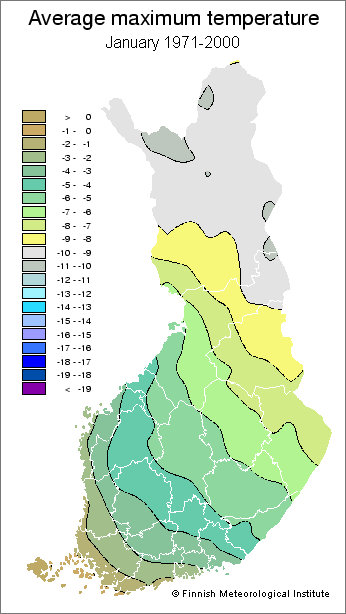“Weather notes”:
|
In Finland the weather can vary greatly during one day, first sunshine, then rain. Rapid changes in the weather are a characteristic feature from one day to the next. In the winter troughs of low pressure that have formed over the North Atlantic bring mild, cloudy and wet weather on southerly and southwesterly winds. The hottest weather in the summer, on the other hand, generally comes from the southeast, bringing thunderstorms and heavy rain showers.
As far as tourism in Finland is concerned, the weather both in summer and winter has its own exotic attraction. Autumn and spring are short and the weather in those seasons has its own beautiful features reflected by the natural surroundings. The striking tints on the leaves in Lapland in September are particularly splendid. The rich colours of the autumn last a week or two, their timing varying from year to year. Leaves obtain their colourful tints after a few nights of frost. Once these colours fade away in the north, they reappear quickly in southern Lapland. Elsewhere in Finland the period of autumn foliage occurs during September and October. In March and April the spring snow in Lapland glistens under the plentiful sunlight, a magnificent time for a winter holiday.
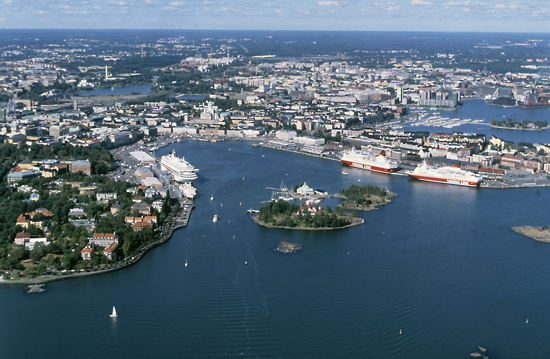
View of Helsinki South Harbour in summer. Photo: Finnish Tourist Board.
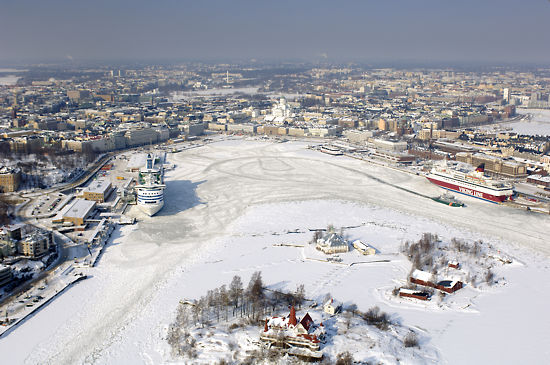
The same view in winter. Photo: FTB/Karsten Bidstrup
Because of our northern location and because nights are light from the end of May to the beginning of August there is daylight in summertime around the clock across the whole of Finland. Lapland, north of the Arctic Circle, has “nightless nights” in the middle of the summer, when the sun does not sink beneath the horizon at all. This period starts at the end of May and continues to mid-July. In the far north of Lapland the nightless nights last from May 17 to July 27.
In the middle of winter, in contrast, daytime is very short. In the south of the country daylight in December lasts only for 6 hours. In northern Lapland a period of darkness prevails at that time, with the sun not rising above the horizon at all. In the far north of Lapland (69-70 °N) the sun stays below the horizon for the whole of December and the period of gloom does not end until January 16. But in Sodankylä (67.3 °N) the sun is below the horizon only for a few days around Christmas.
In the middle of winter it is memorable to experience the dawning of a day on the southern sky around noon. Clear weather allows one to see outdoors for a few hours, but soon the darkness takes over. However, when the sky is clear, it is not pitch black. A layer of clean white snow increases the brightness by as much as 80%, because artificial lights and moonlight are reflected off it. It is only completely dark when very thick cloud covers the sky and there is drizzle or mist.
Moonlight provides its own splendid atmosphere on the fells, not to mention the glowing of the Northern Lights in the grey-blue sky. The period of grey is really long throughout the country in the winter, 1.5 hours before dawn and the same duration after sunset. On clear days the beautiful, blue-tinted grey can be enjoyed for a long time, much longer than in central and southern Europe.
1. Location determines weather and climate
Finland is situated right in the far north, between latitudes 60 – 70 °N. At similar latitudes in other parts of the world, such as Siberia and Canada, it is much colder than in Fennoscandia. In the autumn and winter in particular the weather in Finland is dominated by troughs of low pressure that form over the North Atlantic and usually come to Finland from the west or southwest. As far as weather coming from the Atlantic is concerned, Finland is situated behind the Scandian mountain range, which separates Norway from Sweden. Both the Scandian mountain range and the landmass of southern Scandinavia reduce the effect of storms and rainfall before they reach Finland. Conversely, Finland is quite close to the Arctic Ocean, from where the northern winds bring cold, although clear and bright, freezing weather in winter.
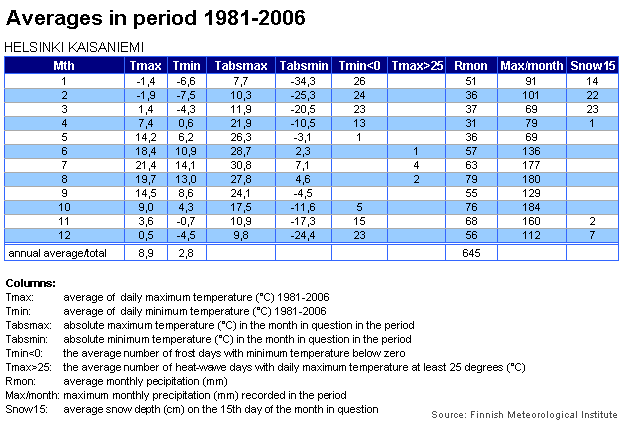
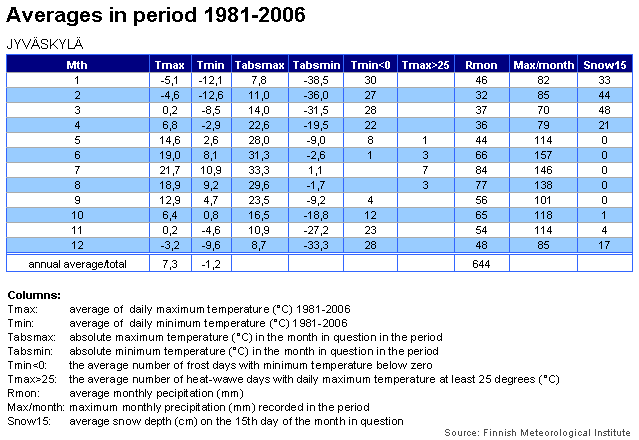

In summer Finland receives doses of cold air from the north and northeast. The cold air first arrives in Lapland, from where it spreads rapidly to central and southern parts of the country. Sometimes in January or February continental winter high pressure that has formed in Siberia moves westwards and brings dry but icily cold weather to Finland, especially the eastern part of the country as well as Lapland.
Finland’s northern location and the closeness of a big ocean can be clearly seen in the climate statistics (tables for a number of localities for the period 1981-2006). They show the weather statistics at both average and record values. You can make comparisons with the climate of your own country.
2. Summer weather
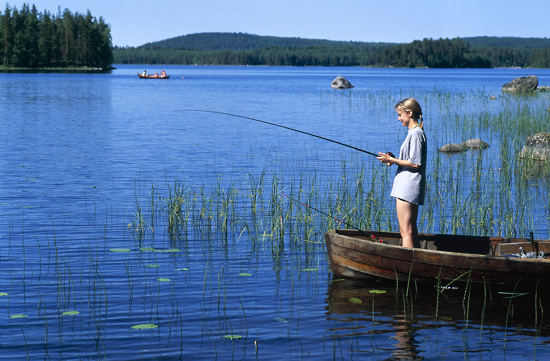
© Finnish Tourist Board
The climate is becoming warmer all over the world, including Finland, where in the 2000s summers have often been warmer than usual. Hot spells are more frequent and they last longer. In Finland, days when the highest temperature is above 25 degrees Celsius are recorded as hot days. Some increase in summer rainfall is also expected. The summer rains accumulate from numerous showers. Spells of dry summer weather with no rain are likewise forecast to become longer.
Hot and record-dry summers or comfortably warm summers with heavy rainfall have been experienced in Finland for more than ten years. The last cool summer occurred in 1998.
Although in the long term Finnish summers will become warmer, the weather will still vary greatly; during daytime the sun will shine and showers, accompanied by thunder, will moisten the ground.
Summer temperatures
In summer, even after a chilly night, the temperature in the morning rises to between 10 and 15 degrees Celsius, and the weather warms quickly towards the afternoon. From the Midsummer festival (around June 24) to mid-August afternoon temperatures are typically between 20 and 23 degrees, and in Lapland, too, they are often about 20 degrees. Sometimes cool air spreads from the Arctic Ocean over the whole country. Then the temperature is only 10 – 15 degrees in Lapland during daytime and 15 – 18 degrees in southern and central parts of the country. On cool days it is also often cloudy for part of the day.
Sometimes in summer tropically warm humid air reaches Finland from the southeast or south, raising the daytime temperature to close on 30 degrees or more. Heavy thunderstorms with pouring rain often occur on such days. Sometimes continental high pressure from Siberia moves westwards in summer, bringing very dry, hot weather to Finland. The highest summer temperatures in Finland during the 2000s have varied between 30 and 33 degrees.
In Finland a day is called hot when the afternoon temperature is at least 25 degrees. This criterion was met in June 1999 (22 hot days), July 2003 (27 hot days) and August 2002 (26 hot days). Even at the beginning of September such temperatures are recorded occasionally in southern Finland.
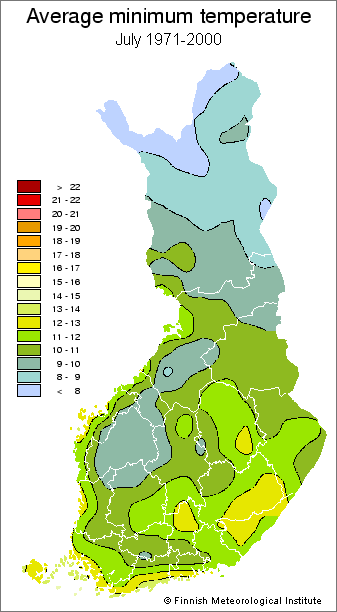
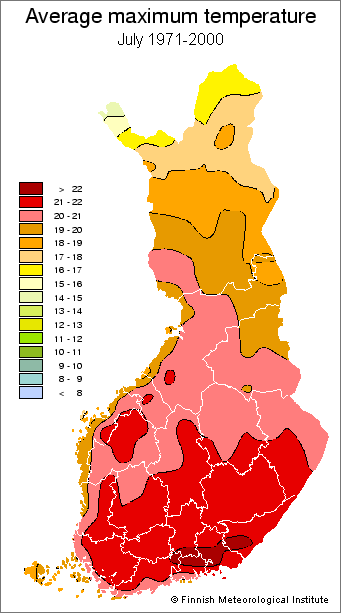
Summer rain and winds
There is relatively little rain in Finland in early summer. The average rainfall in May and June is 40 – 60 mm, compared with 65 – 85 mm in July and August. Summer precipitation is normally in the form of brief rain or thunder showers.
A summer shower in Finland usually lasts for about half an hour. Very few summer days are cloudy or rainy all day long. If there is high pressure, the weather is generally sunny and dry, even if fair-weather cumulus clouds (Cumulus humulis) may develop into thunderstorms (cumulonimbus) in the afternoon. Finland’s coast is sunnier than the interior and has less rainfall. At the beginning of summer it is very sunny on the coast because the sea breeze from the cool sea keeps the rain clouds inland in the afternoon. Only towards evening can they move from inland towards the coast as the wind weakens. When there is a strong ridge of high pressure, the longest spells of dry weather last 2 – 3 weeks.
Average rainfall from June to August varies from 180 millimetres on the coast and in northern Lapland to 225 millimetres inland. Typical rainfall on a summer’s day is 2 – 4 millimetres. Heavy rain showers, however, easily bring between 20 and 40 mm of rain. In a dry summer, such as 2006, it rained less than a half of the average and in places on the coast only a quarter compared with the long-term average. Then again, in the rainiest summers rainfall may reach 300 – 450 millimetres, the years 2004 and 2005 being examples of this.
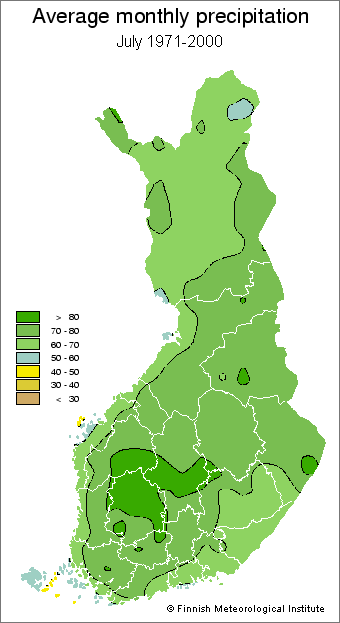
Winds
In summer winds are much lighter than in autumn or winter. In summer the air is often quite calm at night. The wind stirs in the morning as the sun heats up hill and dale. In summer, and winter, too, the prevailing direction of the wind is between south and southwest. The direction of the coastal sea breeze on the Gulf of Finland is between south and southwest but on the Gulf of Bothnia it blows from the west. The effect of the sea breeze extends 10 – 20 kilometres inland from the coast. At night the sea breeze weakens and the coastline becomes calm. At night a contrary land breeze stirs on the sea. Thunder clouds form their own strong gusty winds, thunder squalls, and weather bulletins include warnings about them for land areas and coastal and inland waters.
Sunshine
Many coastal towns advertise themselves as being the sunniest places in Finland in the summer, which, according to the sunshine statistics, holds true compared with localities inland. The sun shines most at sea in the southwestern archipelago and on the coast. The average number of hours of sunshine on the coast in May and June is more than 300, whilst inland the figure is slightly lower. In July, because of rain and thunder, there are fewer than 300 hours of sunshine, and as the days shorten, especially in August, the sun shines less.
Because in the north the sun is above the horizon in the middle of summer for a long time, it is possible to enjoy sunlight on clear days for 18 – 19 hours in southern Finland and 24 hours in Lapland. On a typical summer day including the shade from rain and thunder clouds, it is possible to enjoy an average of 9 – 10 hours of sunlight per day. In Finland, too, ultraviolet radiation from the sun is strong on either side of midday in summer. Protecting oneself from sunshine between 11.00 and 15.00 is highly recommended.
Thunder
In the middle of summer (July-August) enormous thunderclouds can develop in Finland, almost like in the tropics. Flashes of lightning are frequent and heavy rain is also part of the picture. Hailstones may also fall but they are fairly rare. Widespread storm systems that cause damage occur less frequently than once every other summer. With warming of the climate, the frequency of violent thunderstorms may increase.
Thunderstorms are more frequent in July than in the other summer months, usually on more than 5 days. In the period May to September thunder occurs on average 12 days in southern and central parts of the country,but less frequently on the coast and in northern Finland. The number of thundery days per year varies from 6 to 20.
3. Autumn weather
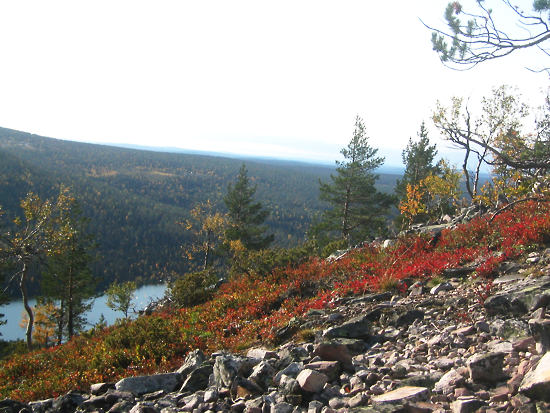
Photo: Eija Vallinheimo/FMI
In Finland summer weather fades into autumn as August comes to an end. In Lapland autumn weather starts at the end of August, with the advent of the first real frosty nights. In Lapland the period of colourful autumn foliage begins,lasting a few weeks and steadily moving southwards. In southern Finland,especially on the coast, summer temperatures linger until mid-September. There are a few days of summer warmth at the beginning of September. In September, too, the first snow usually falls in the north, but soon melts away.
The autumn equinox, when day and night are of equal length all over the world, occurs on September 21. Thereafter, the days become shorter every day until Christmas.
At the end of October the temperature is about six degrees lower than at the beginning of the month. At the beginning of the month the average daytime temperature in Lapland is 5 degrees and in southern Finland 10 degrees, whereas at the end of the month it is just below zero during the day in the north and 5 degrees in the south. Sometimes there are frosty nights and mornings in southern Finland, too, and the first snow in central parts of the country often falls in October.
By November the change to normal time has been made and the daylight keeps getting shorter. November is also the time of winter storms. Deep troughs of low pressure coming from the Atlantic bring stormy winds and rain. There are, on average, four stormy days in Finnish sea areas in November, which shows that stormy winds do not blow in Finland all the time. Precipitation may start as snow, but the further south it moves the more likely it is to fall as rain.
4. Winter weather
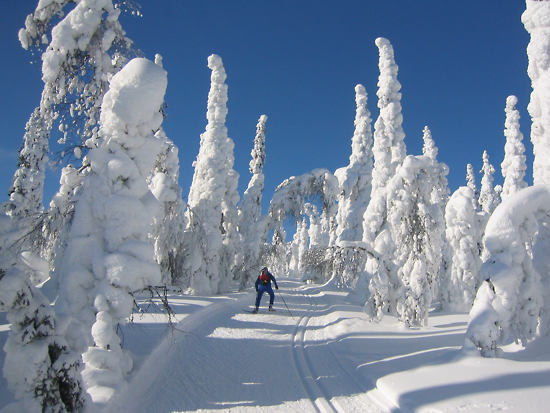
Photo: Eija Vallinheimo/FMI
The changeover to winter weather in Finland takes place fairly quickly in November and December. Winds blowing from the north bring cold air from the Arctic Ocean. In Lapland the weather is wintry in November. In fact in northern Finland in general and in parts of eastern Finland, too, the ground is usually already covered in snow in November. Southern and southwestern parts of the country get a permanent snow cover in December. This is preceded by several snowfalls that usually melt away. For example, the average date for the start of the permanent snow cover in the Helsinki region is Christmas Day, December 25. In the extensive archipelago off the southwestern part of the mainland the snow cover does not become permanent until the New Year.
The increasing mildness of winter is apparent in the 2000s in weather statistics: rain and drizzle are more common than they used to be. It often rains in December, sometimes even in January and February. Temporary thaws accompanied by rain do not melt the snow in Lapland, although they do further south. During the past 15 years record mild early winters have been experienced, in 2006 for example, when it was almost December before the first snowfalls occurred in the north. The warming of the climate is making winters start later than previously throughout the whole country.
Winter temperatures
Winter is the longest season in Finland. According to climatic definition, when the average daily temperature remains below zero, it is winter. Winter weather in the southwestern archipelago, when the sea is ice-free, lasts about three months (December-February) and in northern Lapland more than six months, from mid-October to the end of April. In the central part of the country winter weather usually prevails from November to the beginning of April, and in the interior of southern Finland from December to the end of March.
Winter in Finland includes days when the temperature is above zero. There are, on average, 6 – 10 such days, often with drizzle or rain, in each winter month in the south of the country, and 2 – 8 days in central Finland. In really mild winters it even rains for a few days in Lapland. In winter the drizzle is often freezing, and this makes road conditions very slippery. Radio stations issue warnings about the hazardous conditions which require extra caution from road users.
The coldest time in midwinter (the period from December through February) is January in Lapland, and the beginning of February in a typical winter in the south. The temperature on a winter day is determined to a large extent by whether cold, dry air has flowed to Finland from the north, in which case the weather is clear, or a moist, windy and cloudy thaw, warmed by the Atlantic, has moved in from the southwest. In winter the sun does not warm the air as it is low, close to the horizon. But the situation changes rapidly in February-March, because in March, around the time of the vernal equinox, the warming effect of the sun is already considerable. This is particularly so in Lapland. In Lapland’s glistening snow in March – April sunshine can raise the temperature from 15 degrees below zero in the morning to above zero later in the day. In clear weather the sun gives off a maximum of 20 degrees of heat. Further south change in temperature over the course of a day is somewhat smaller than in Lapland.
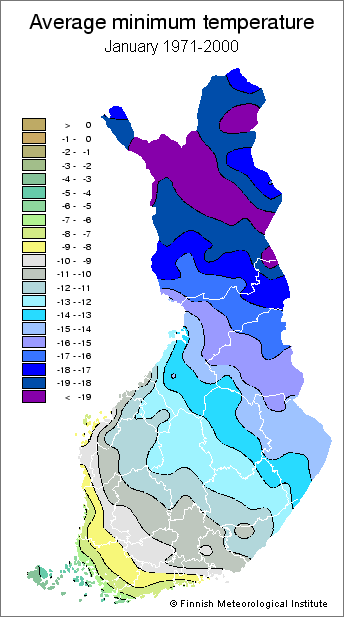
Snow cover
Winter weather arrives first in the north. In Lapland the tops of the high hills, or fells, generally receive their first coating of snow at the end of August or in September. A permanent snow cover settles on northern and central Lapland on average after mid-October. It is usually preceded by 2 – 3 snowfalls that melt away. The timing of the start of permanent winter varies greatly in different years. In the province of Oulu and in central Finland the first snow typically falls in October, but the period of permanent snow cover does not begin until about a month later. On the coast, as long as the sea is free of ice, the snow cover appears and melts numerous times at the beginning of winter. In Helsinki, for example, the snow cover melted away 14 times in the early stage of the winter of 1992-1993.
The southwestern part of the country and the coastal areas receive a permanent snow cover during December on average, and it arrives earlier inland than by the open sea. The Åland Islands and the Turku archipelago are the areas with the shortest period of snow cover. In both areas the snow comes at the turn of the year and the final remnants melt away at the beginning of March at the latest.
The snow cover is usually at its deepest in mid-March, although in Lapland the maximum is not reached until early April. In a typical winter the greatest snow depth is only 10 – 30 cm in southwestern Finland, in the western province of Ostrobothnia and on the coast. In southeastern and eastern Finland the snow cover is between 40 – 70 cm in the middle of March. In the hilly areas of eastern Finland, in the region of Kainuu and in most of Lapland the snow cover amounts to 60 – 100 cm in early April. The depth of the snow cover depends on the type of winter weather and it can vary greatly from the long-term average. Snowfalls and the depth of snow cover are decreasing as the climate becomes warmer. The duration of the snow cover is gradually shortening at both ends.
In spring, specifically in March, snow melts fairly quickly because the sun then gives off a great deal of warmth. At this time of year, the snow softens into crystals during the day and some of it melts, but with freezing temperatures at night it solidifies once again. The southern slopes lose their snow cover quickly because the sun’s rays are directed on them. In the forests and shaded places on northern slopes snow disappears 1 – 2 weeks later than in open spaces. In coastal regions and the south of the country the snow cover has disappeared completely by the beginning of April. The earth reveals itself in eastern Finland and the province of Oulu between the end of April and May 10. Only in central and northern Lapland can the snow cover locally linger until the end of May.
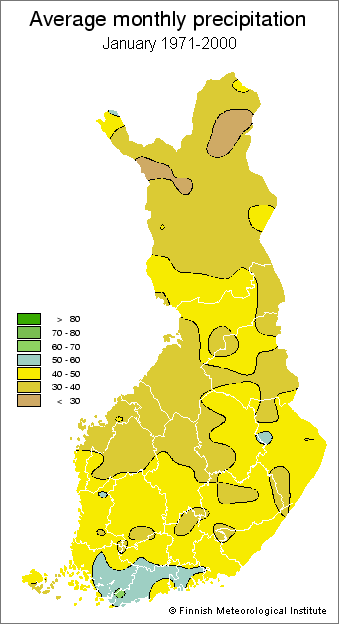
Winds
The windiest periods are autumn and, in particular, the winter months. In Finland’s maritime areas storm-force readings (more than 21 m/s) are recorded on average on four days in November, December and January. The number of stormy days per year fluctuates greatly. The windiest winter in recent decades was in 1992 – 1993, when there were 30 days of storms in Finland’s maritime areas between November and January. And in November 2001 there were exceptionally severe autumn storms, which caused damage to forests in inland areas.
5. Late winter and spring
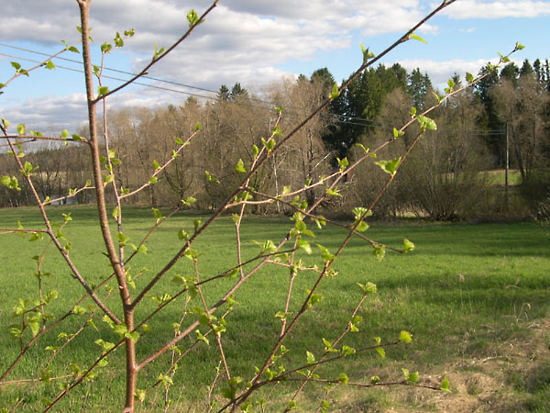
Photo: Eija Vallinheimo/FMI
The months of late winter and spring are March, April and part of May. Springtime is characterized by light winds, clear weather and sunshine during the daytime. This pattern is, however, sometimes interrupted by troughs of low pressure arriving from the southwest and bringing snow and sleet and a cold spell in spring as late as May. The evenings have already been light for several weeks. Spring starts in the southern part of the country first, and spreads out in a good seven weeks over the entire country. In March-April the sun sheds powerful warmth on the dark forests and the ground, which has reappeared from under the snow. In spring, snow and the ice on lakes and on the sea melt. In the south lakes and rivers lose their ice cover at the end of April, while in the north this occurs during May.
Temperatures
In spring the temperature varies greatly between night and day as the sun brings warmth during the daylight hours. On a clear night the temperature often falls below zero. Around dawn, in southern and central parts of the country, as the sun rises, the lowest temperatures are below zero. In Lapland they are well below zero. In March, in fact, the temperature there can drop to minus 30 and in April to minus 20 degrees. But on a sunny morning the temperature rises above zero rapidly. At the beginning of March the daytime temperature is typically around zero in southern and central parts of the country, but at the end of April it is already above 10 degrees. In recent years it has occasionally been as high as 20 degrees at the end of April. In northern Finland, on the other hand, the daytime temperature rises from –5 at the beginning of March to +5 at the end of April. In cloudy weather there is little variation in the temperature during the course of the day.
Rain and wind
In spring there is little rainfall in Finland because the atmosphere in the northern hemisphere is dry after the cold winter. That is why it is often clear and sunny in spring. Although rainfall amounts are generally quite small, snow may fall persistently. Sometimes the south of Finland experiences a cold spell in May, when snow falls and the temperature is only just above zero.
In the spring the winds are much lighter than in winter. A storm-force wind on the sea is rare in the spring months; on average there is only one stormy day per month. In May, as in the other summer months, there is, according to statistics, only one stormy day in two years.
By Anneli Nordlund, senior meteorologist, Finnish Meteorological Institute, January 2008
